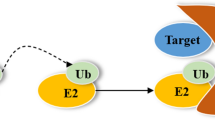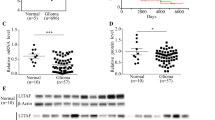Abstract
Tumor necrosis factor receptor-associated factor 6 (TRAF6), which plays an important role in inflammation and immune response, is an essential adaptor protein for the NF-κB (nuclear factor κB) signaling pathway. Recent studies have shown that TRAF6 played an important role in tumorigenesis and invasion by suppressing NF-κB activation. However, up to now, the biologic role of TRAF6 in glioma has still remained unknown. To address the expression of TRAF6 in glioma cells, four glioma cell lines (U251, U-87MG, LN-18, and U373) and a non-cancerous human glial cell line SVG p12 were used to explore the protein expression of TRAF6 by Western blot. Our results indicated that TRAF6 expression was upregulated in human glioma cell lines, especially in metastatic cell lines. To investigate the role of TRAF6 in cell proliferation, apoptosis, invasion, and migration of glioma, we generated human glioma U-87MG cell lines in which TRAF6 was either overexpressed or depleted. Subsequently, the effects of TRAF6 on cell viability, cell cycle distribution, apoptosis, invasion, and migration in U-87MG cells were determined with 3-(4,5-dimethylthiazol-2-yl) 2,5-diphenyl tetrazolium bromide (MTT) assay, flow cytometry analysis, transwell invasion assay, and wound-healing assay. The results showed that knockdown of TRAF6 could decrease cell viability, suppress cell proliferation, invasion and migration, and promote cell apoptosis, whereas overexpression of TRAF6 displayed the opposite effects. In addition, the effects of TRAF6 on the expression of phosphor-NF-κB (p-p65), cyclin D1, caspase 3, and MMP-9 were also probed. Knockdown of TRAF6 could lower the expression of p-p65, cyclin D1, and MMP-9, and raise the expression of caspase 3. All these results suggested that TRAF6 might be involved in the potentiation of growth, proliferation, invasion, and migration of U-87MG cell, as well as inhibition of apoptosis of U-87MG cell by abrogating activation of NF-κB.








Similar content being viewed by others
References
Farias-Eisner G, Bank AM, Hwang BY, Appelboom G, Piazza MA, Bruce SS, Sander Connolly E (2012) Glioblastoma biomarkers from bench to bedside: advances and challenges. Br J Neurosurg 26:189–194
Walecki J, Tarasow E, Kubas B, Czemicki Z, Lewko J, Podgorski J, Sokol M, Grieb P (2003) Hydrogen-1 MR spectroscopy of the peritumoral zone in patients with cerebral glioma: assessment of the value of the method. Acad Radiol 10:145–153
Ferguson SD (2011) Malignant gliomas: diagnosis and treatment. Dis Mon 57:558–569
Rainov NG, Heidecke V (2011) Clinical development of experimental therapies for malignant glioma. Sultan Qaboos Univ Med J 11:5–28
Yamanaka R, Kajiwara K (2012) Dendritic cell vaccines. Adv Exp Med Biol 746:187–200
Jin HR, Jin SZ, Cai XF, Li D, Wu X, Nan JX, Lee JJ, Jin X (2012) Cryptopleurine targets NF-kappaB pathway, leading to inhibition of gene products associated with cell survival, proliferation, invasion, and angiogenesis. PLoS One 7:e40355
Liu YQ, Hu XY, Lu T, Cheng YN, Young CY, Yuan HQ, Lou HX (2012) Retigeric acid B exhibits antitumor activity through suppression of nuclear factor-kappaB signaling in prostate cancer cells in vitro and in vivo. PLoS One 7:e38000
Kang K, Lim JS (2012) Induction of functional changes of dendritic cells by silica nanoparticles. Immune Netw 12:104–112
Prasad S, Yadav VR, Sung B, Reuter S, Kannappan R, Deorukhkar A, Diagaradjane P, Wei C, Baladandayuthapani V, Krishnan S et al (2012) Ursolic acid inhibits growth and metastasis of human colorectal cancer in an orthotopic nude mouse model by targeting multiple cell signaling pathways: chemosensitization with capecitabine. Clin Cancer Res 18:4942–4953
Ge Y, Xu Y, Sun W, Man Z, Zhu L, Xia X, Zhao L, Zhao Y, Wang X (2012) The molecular mechanisms of the effect of dexamethasone and cyclosporin A on TLR4/NF-kappaB signaling pathway activation in oral lichen planus. Gene 508:157–164
Jia L, Gopinathan G, Sukumar JT, Gribben JG (2012) Blocking autophagy prevents bortezomib-induced NF-kappaB activation by reducing I-kappaBalpha degradation in lymphoma cells. PLoS One 7:e32584
Gupta SC, Sundaram C, Reuter S, Aggarwal BB (2010) Inhibiting NF-kappaB activation by small molecules as a therapeutic strategy. Biochim Biophys Acta 1799:775–787
Tsuchiya Y, Asano T, Nakayama K, Kato T Jr, Karin M, Kamata H (2010) Nuclear IKKbeta is an adaptor protein for IkappaBalpha ubiquitination and degradation in UV-induced NF-kappaB activation. Mol Cell 39:570–582
Tao T, Cheng C, Ji Y, Xu G, Zhang J, Zhang L, Shen A (2012) Numbl inhibits glioma cell migration and invasion by suppressing TRAF5-mediated NF-kappaB activation. Mol Biol Cell 23:2635–2644
Tran NL, McDonough WS, Savitch BA, Fortin SP, Winkles JA, Symons M, Nakada M, Cunliffe HE, Hostetter G, Hoelzinger DB et al (2006) Increased fibroblast growth factor-inducible 14 expression levels promote glioma cell invasion via Rac1 and nuclear factor-kappaB and correlate with poor patient outcome. Cancer Res 66:9535–9542
Sarkar D, Park ES, Emdad L, Lee SG, Su ZZ, Fisher PB (2008) Molecular basis of nuclear factor-kappaB activation by astrocyte elevated gene-1. Cancer Res 68:1478–1484
Sung B, Pandey MK, Nakajima Y, Nishida H, Konishi T, Chaturvedi MM, Aggarwal BB (2008) Identification of a novel blocker of IkappaBalpha kinase activation that enhances apoptosis and inhibits proliferation and invasion by suppressing nuclear factor-kappaB. Mol Cancer Ther 7:191–201
Ichikawa H, Takada Y, Murakami A, Aggarwal BB (2005) Identification of a novel blocker of I kappa B alpha kinase that enhances cellular apoptosis and inhibits cellular invasion through suppression of NF-kappa B-regulated gene products. J Immunol 174:7383–7392
Schneider M, Zimmermann AG, Roberts RA, Zhang L, Swanson KV, Wen H, Davis BK, Allen IC, Holl EK, Ye Z et al (2012) The innate immune sensor NLRC3 attenuates Toll-like receptor signaling via modification of the signaling adaptor TRAF6 and transcription factor NF-kappaB. Nat Immunol 13:823–831
Maruyama K, Kawagoe T, Kondo T, Akira S, Takeuchi O (2012) TRAF family member-associated NF-kappaB activator (TANK) is a negative regulator of osteoclastogenesis and bone formation. J Biol Chem 287:29114–29124
Zhou F, Zhang X, van Dam H, Ten Dijke P, Huang H, Zhang L (2012) Ubiquitin-specific protease 4 mitigates toll-like/interleukin-1 receptor signaling and regulates innate immune activation. J Biol Chem 287:11002–11010
Hamidi A, von Bulow V, Hamidi R, Winssinger N, Barluenga S, Heldin CH, Landstrom M (2012) Polyubiquitination of transforming growth factor beta (TGFbeta)-associated kinase 1 mediates nuclear factor-kappaB activation in response to different inflammatory stimuli. J Biol Chem 287:123–133
Wang HJ, Ruan HJ, He XJ, Ma YY, Jiang XT, Xia YJ, Ye ZY, Tao HQ (2010) MicroRNA-101 is down-regulated in gastric cancer and involved in cell migration and invasion. Eur J Cancer 46:2295–2303
Jacobs W, Mikkelsen T, Smith R, Nelson K, Rosenblum ML, Kohn EC (1997) Inhibitory effects of CAI in glioblastoma growth and invasion. J Neurooncol 32:93–101
Meng QH, Zhou LX, Luo JL, Cao JP, Tong J, Fan SJ (2005) Effect of 7-hydroxystaurosporine on glioblastoma cell invasion and migration. Acta Pharmacol Sin 26:492–499
Walsh MC, Kim GK, Maurizio PL, Molnar EE, Choi Y (2008) TRAF6 autoubiquitination-independent activation of the NFkappaB and MAPK pathways in response to IL-1 and RANKL. PLoS One 3:e4064
Inubushi T, Kawazoe A, Miyauchi M, Kudo Y, Ao M, Ishikado A, Makino T, Takata T (2012) Molecular mechanisms of the inhibitory effects of bovine lactoferrin on lipopolysaccharide-mediated osteoclastogenesis. J Biol Chem 287:23527–23536
Hartupee J, Li X, Hamilton T (2008) Interleukin 1alpha-induced NFkappaB activation and chemokine mRNA stabilization diverge at IRAK1. J Biol Chem 283:15689–15693
Lim KH, Yang Y, Staudt LM (2012) Pathogenetic importance and therapeutic implications of NF-kappaB in lymphoid malignancies. Immunol Rev 246:359–378
Baldwin AS (2012) Regulation of cell death and autophagy by IKK and NF-kappaB: critical mechanisms in immune function and cancer. Immunol Rev 246:327–345
Ling J, Kumar R (2012) Crosstalk between NF-kB and glucocorticoid signaling: a potential target of breast cancer therapy. Cancer Lett 322:119–126
Zhong L, Cao F, You Q (2012) Effect of TRAF6 on the biological behavior of human lung adenocarcinoma cell. Tumour Biol. doi:10.1007/s13277-012-0543-8
Liu H, Zhang T, Ye J, Li H, Huang J, Li X, Wu B, Huang X, Hou J (2012) TNF receptor-associated factor 6 in advanced non-small cell lung cancer: clinical and prognostic implications. J Cancer Res Clin Oncol 138:1853–1863
Chaudhry SI, Hooper S, Nye E, Williamson P, Harrington K, Sahai E (2012) Autocrine IL-1beta-TRAF6 signalling promotes squamous cell carcinoma invasion through paracrine TNFalpha signalling to carcinoma-associated fibroblasts. Oncogene. doi: 10.1038/onc.2012.91
Meng Q, Zheng M, Liu H, Song C, Zhang W, Yan J, Qin L, Liu X (2012) TRAF6 regulates proliferation, apoptosis, and invasion of osteosarcoma cell. Mol Cell Biochem 371:177–186
Li YF, Xu XB, Chen XH, Wei G, He B, Wang JD (2012) The nuclear factor-kappaB pathway is involved in matrix metalloproteinase-9 expression in RU486-induced endometrium breakdown in mice. Hum Reprod 27:2096–2106
Cock-Rada AM, Medjkane S, Janski N, Yousfi N, Perichon M, Chaussepied M, Chluba J, Langsley G, Weitzman JB (2012) SMYD3 promotes cancer invasion by epigenetic upregulation of the metalloproteinase MMP-9. Cancer Res 72:810–820
Yang L, Zeng W, Li D, Zhou R (2009) Inhibition of cell proliferation, migration and invasion by DNAzyme targeting MMP-9 in A549 cells. Oncol Rep 22:121–126
Jee BK, Park KM, Surendran S, Lee WK, Han CW, Kim YS, Lim Y (2006) KAI1/CD82 suppresses tumor invasion by MMP9 inactivation via TIMP1 up-regulation in the H1299 human lung carcinoma cell line. Biochem Biophys Res Commun 342:655–661
Author information
Authors and Affiliations
Corresponding author
Additional information
An erratum to this article is available at http://dx.doi.org/10.1007/s11010-016-2682-5.
The Editor-in-Chief retracts this article as per the Committee on Publication Ethics (COPE) guidelines on plagiarism. After a thorough investigation, it was found that there is a striking level of similarity in the layout and content of this paper with another publication (Tumor Biology (2013) 34:231-239; doi:10.1007/s13277-012-0543-8). It is also pointed out that the authors have failed to the authors have failed to respond to these similarity issues, first brought to their attention in 2015.
About this article
Cite this article
Peng, Z., Shuangzhu, Y., Yongjie, J. et al. RETRACTED ARTICLE: TNF receptor-associated factor 6 regulates proliferation, apoptosis, and invasion of glioma cells. Mol Cell Biochem 377, 87–96 (2013). https://doi.org/10.1007/s11010-013-1573-2
Received:
Accepted:
Published:
Issue Date:
DOI: https://doi.org/10.1007/s11010-013-1573-2




